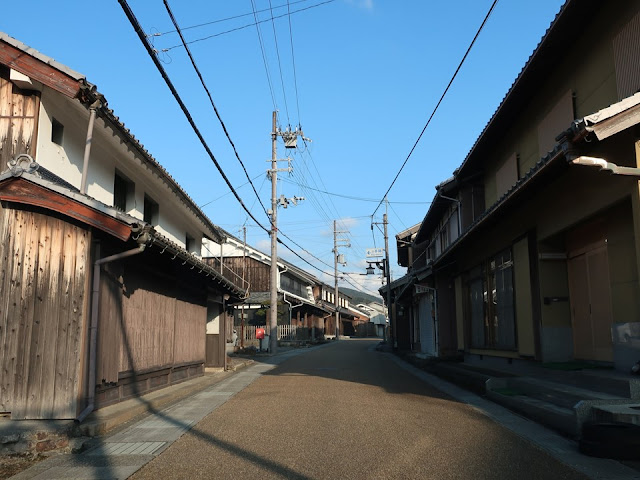Tenmakan (pavilion) is in Tsuchiyama post town on Toukaidou highway which linked Tokyo and Kyoto. (Reference: Kaido (Highway) and Shukuba (Post town) ) Tsuchiyama is west of difficult Suzuka pass. Tenmakan introduces Tsuchiyama and is also a community center of this town. This large building was donated by a farmer.
土山宿は、東海道の難所・鈴鹿峠の西側にありました。東海道伝馬館は、宿場を紹介する旧街道沿いの施設で、展示場でありコミュニティセンターでもあります。農家の寄贈を受けた立派な建物で、NPO法人が運営しています。
There is a rebuilt building of an officer of this post town. A model of a worker on the right takes care of a horse.
門を入って左手には、宿場役人や馬の世話などをする人夫の人形があります。
A model of a Sankin-koutai procession which referred to Kaga-han and Kumamoto-han is exhibited. Those dolls are made in Kyoto. (Reference: Daimyo lord and han)
蔵には大名行列が展示されています。加賀藩、熊本藩の行列を参考にした京人形です。
The main building is called Rekishi (history) Kairou (corridor).
メインの建物、歴史回廊。
This is a model of this post town on the first floor.
一階には土山宿のジオラマがあります。
On the second floor, paper cutouts of fifteen-three post towns on Toukaidou, which were donated by the local artist, and the specialties of each post town are exhibited.
二階には東海道五十三次の宿場の切り絵と名物の模型とともに展示されています。切り絵は地元の方が寄贈した作品です。
The specialty of Tsuchiyama is tea leaves. It’s timeless fun for people to travel while enjoying specialty dishes.
土山宿の名物はお茶。名物をいただきながら旅をするのは今も昔も楽しみです。
People in Tsuchiyama were depicted vividly.
土山宿。人々が活き活きと描かれています。
In the other room on the second floor, Bon (tray) -kei (scene) are exhibited. Those were models of Hiroshige’s printing of Toukaidou on the trays. It's worth watching.
二階の別な部屋には、お盆の中に、広重の東海道五十三次を模型で作った盆景が展示されている。こちらも見応えがあります。
Bon (tray) -kei (scene) of Tsuchiyama、土山宿の盆景
You can take photos while wearing travel gears in the Edo period (1603~1868) . 旅装束で写真を撮れるコーナー
Outfits for traveling in the Edo period
These panels show us Tsuchiyama and Toukaidou in the Edo period. Tea leaves are sold in front of the panels. A kind elder woman told us that the national-wide folk song contest was held there, the population of young people were declining and so on.
東海道と土山宿をパネルで紹介のコーナーでは、名物のお茶も売られていました。人の良いおばあさんが販売していて、馬子唄の全国大会が開かれること、若い人が減ったことなどいろいろとお話をして下さいました。
Honjin, which was a hotel for daimyo lords and nobles, is a private house now.
本陣の旧土山家。今も人が住み、表札があがっています。
The road goes to Suzuka pass.
旧東海道。道が鈴鹿峠へと続いていきます。
Location of Tsuchiyama
Additional info:
There is a city museum in
Tsuchiyama, I’ll visit another time.
土山には、甲賀市立の土山歴史民俗資料館
があります。こちらはまた今度。
http://www.city.koka.lg.jp/5968.htm
(in Japanese)
Visited in February, 2020
Official website: http://www.tokaido.or.jp/tenmakan/top.html
(in Japanese), accessed in September, 2020
Previous post (Museum in Ise which the popular tourist destination):
Ise
Furuichi Sangu-kaido Museum 伊勢古市参宮街道資料館
Next post (Shrines
which has many cultural assets in Yoshino, Nara):

















Comments
Post a Comment